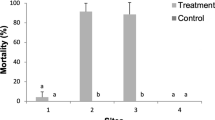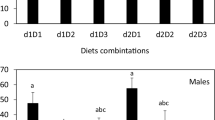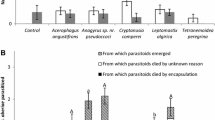Abstract
Four Chewings fescue and two strong creeping red fescue selections that had been artificially inoculated and stably maintained with four different endophytes were evaluated in feeding trials with chinch bugs (Blissus leucopterus hirtus). Significant differences in survival were found between the endophyte-inoculated plants and their endophyte-free counterparts. After seven days, 54.2% of chinch bugs were alive on endophyte-free tillers versus only 7.4% of chinch bugs fed tillers from endophyte-inoculated plants. Some differences were also found among the various plant–endophyte combinations. In Petri dish preference trials, chinch bugs showed a preference for the CA endophyte (obtained from a Chewings fescue) over the RC endophyte (obtained from a strong creeping red fescue) in Chewings fescue selection C1117. Only the inoculated plants produced erogvaline, peramine, and lolitrem B; moreover, significant differences were found among the plant–endophyte combinations in the levels of these alkaloids. The Chewings selections C1117 and C1090 produced more ergovaline, and C1090 more lolitrem B, than other plants, regardless of endophyte source. In the presence of the RC endophyte, more ergovaline and lolitrem B was produced than in the presence of the CA endophyte regardless of plant genotype. Both host plant and endophyte, therefore, contributed factors that determined alkaloid production. No significant correlations between chinch bug survival and alkaloid levels were found, however, and overall, no one plant genotype or endophyte source proved to be significantly more toxic than another to chinch bugs. Nevertheless, the results clearly demonstrated that artificial inoculations of endophyte-free fescue genotypes can produce plants with increased toxicity to chinch bugs.
Similar content being viewed by others
REFERENCES
Agee,Ñ C.ÑS.,ÑandÑ Hill,Ñ N.ÑS.Ñ1994.ÑErgovalineÑvariabilityÑinÑAcremonium-infectedÑtallÑfescueÑdueÑtoÑenvironmentÑandÑplantÑgenotype.ÑCropÑSci.Ñ34:221–226.
Bacon,Ñ C.ÑW.ÑandÑ DeÑBattista,Ñ J.ÑP.Ñ1990.ÑEndophyticÑfungiÑofÑgrass,Ñpp.Ñ231–256,ÑinÑD.ÑK.Ñ AroraÑ(ed.).ÑHandbookÑofÑAppliedÑMycology,ÑVol.Ñ1,ÑSoilÑandÑPlant.ÑMarcelÑDekker,Ñ NewÑYork.
Bacon,Ñ C.ÑW.,ÑRichardson,Ñ M.ÑD.,ÑandÑ White,Ñ J.ÑF.,ÑJr.Ñ1997.ÑModificationÑandÑusesÑofÑendophyteenhancedÑturfgrass:ÑAÑroleÑforÑmolecularÑtechnology.ÑCropÑSci.Ñ37:1415–1425.
Baker,Ñ P.ÑB.,ÑRatcliffe,Ñ R.ÑH.,ÑandÑ Steinhauer,Ñ A.ÑL.Ñ1981.ÑLaboratoryÑrearingÑofÑtheÑhairyÑchinchÑbug.ÑEnviron.ÑEntomol.Ñ10:226–229.
Ball,Ñ O.ÑJ.-P.,ÑPrestidge,Ñ R.ÑA.,ÑandÑ Sprosen,Ñ J.ÑM.Ñ1995.ÑInterrelationshipsÑbetweenÑAcremoniumÑlolii,Ñperamine,ÑandÑlolitremÑBÑinÑperennialÑryegrass.ÑAppl.ÑEnviron.ÑMicrobiol.Ñ61:1527–1533.
Ball,Ñ O.ÑJ.-P.,ÑBarker,Ñ G.ÑM.,ÑPrestidge,Ñ R.ÑA.,ÑandÑ Lauren,Ñ D.ÑR.Ñ1997a.ÑDistributionÑandÑaccumulationÑofÑtheÑalkaloidÑperamineÑinÑNeotyphodiumÑlolii-infectedÑperennialÑryegrass.ÑJ.ÑChem.ÑEcol.Ñ23:1419–1434.
Ball,Ñ O.ÑJ.-P.,ÑMiles,Ñ C.ÑO.ÑandÑ Prestidge,Ñ R.ÑA.Ñ1997b.ÑErgopeptineÑalkaloidsÑandÑNeotyphodiumÑlolii-mediatedÑresistanceÑinÑperennialÑryegrassÑagainstÑHeteronychusÑarator.ÑJ.ÑEcon.ÑEntomol.Ñ90:1382–1391.
Barker,Ñ D.ÑJ.,Ñ Davies,Ñ E.,Ñ Lane,Ñ G.ÑA.,Ñ Latch,Ñ G.ÑC.ÑM.,ÑNott,Ñ H.ÑM.,ÑandÑ Tapper,Ñ B.ÑA.Ñ1993.ÑEffectÑofÑwaterÑdeficitÑonÑalkaloidÑconcentrationsÑinÑperennialÑryegrassÑendophyteÑassociations,Ñpp.Ñ67–71,ÑinÑ D.ÑE.Ñ Hume,Ñ G.ÑC.ÑM.Ñ Latch,ÑandÑ H.ÑS.Ñ EastonÑ(eds.).ÑProceedingÑofÑtheÑSecondÑInternationalÑSymposiumÑonÑAcremonium/GrassÑInteractions.ÑAgResearch,Ñ PalmerstonÑNorth,ÑNewÑZealand
Belanger,Ñ F.ÑC.Ñ1996.ÑAÑrapidÑseedlingÑscreeningÑmethodÑforÑdeterminationÑofÑfungalÑendophyteÑviability.ÑCropÑSci.Ñ36:68–74.
Breen,ÑJ.P.Ñ1992.ÑTemperatureÑandÑseasonalÑeffectsÑonÑexpressionÑofÑAcremoniumÑendophyte-enhancedÑresistanceÑtoÑSchizaphisÑgraminumÑ(Homoptera:ÑAphididae).ÑEnviron.ÑEntomol.Ñ21:68–74.
Breen,Ñ J.ÑP.Ñ1993a.ÑEnhancedÑresistanceÑtoÑfallÑarmywormÑinÑAcremoniumÑendophyte-infectedÑturfgrasses.ÑJ.ÑEcon.ÑEntomol.Ñ86:621–629.
Breen,Ñ J.ÑP.Ñ1993b.ÑEnhancedÑresistanceÑtoÑthreeÑspeciesÑofÑaphidsÑinÑAcremoniumÑendophyteinfectedÑturfgrasses.ÑJ.ÑEcon.ÑEntomol.Ñ86:1279–1286.
Breen,Ñ J.ÑP.Ñ1994.ÑAcremoniumÑendophyteÑinteractionsÑwithÑenhancedÑplantÑresistanceÑtoÑinsects.ÑAnnu.ÑRev.ÑEntomol.Ñ9:401–423.
Clarke,Ñ B.ÑB.,ÑWhite,Ñ J.ÑF.,ÑSun,Ñ S.,ÑHuff,Ñ D.ÑR.,ÑandÑ Hurley,Ñ R.ÑH.Ñ2000.ÑEnhancedÑresistanceÑtoÑdollarÑspotÑinÑendophyte-infectedÑfineÑfescue.ÑPlantÑDis.Ñ84:ÑInÑpress.
Dowdy,Ñ S.,ÑandÑ Hearden,Ñ S.Ñ1991.ÑStatisticsÑforÑResearch,Ñ2ndÑed.ÑJohnÑWileyÑ&ÑSons,Ñ NewÑYork.
Funk,Ñ C.ÑR.,ÑandÑ White,Ñ J.ÑF.Ñ1997.ÑUseÑofÑnaturalÑandÑtransformedÑendophytesÑforÑturfÑimprovement,Ñpp.Ñ229–239,ÑinÑC.ÑW.Ñ BaconÑandÑ N.ÑS.Ñ HillÑ(eds.).ÑNeotyphodium/GrassÑinteractions.ÑPlenumÑPressÑ NewÑYork.
Gallagher,Ñ R.T.,ÑHawkes,Ñ A.D.,ÑandÑ Stewart,Ñ J.ÑM.Ñ1985.ÑRapidÑdeterminationÑofÑtheÑneurotoxinÑlolitremÑBÑinÑperennialÑryegrassÑbyÑhigh-performanceÑliquidÑchromatographyÑwithÑfluorescenceÑdetection.ÑJ.ÑChromatogr.Ñ321:217–226.
Hill,Ñ N.ÑS.,ÑParrott,Ñ W.ÑA.,ÑandÑ Pope,Ñ D.ÑD.Ñ1991.ÑErgopeptineÑalkaloidÑproductionÑbyÑendophytesÑinÑaÑcommonÑtallÑfescueÑgenotype.ÑCropÑSci.Ñ31:1545–1547.
Hill,Ñ N.ÑS.,ÑRottinghaus,Ñ C.ÑS.,ÑAgee,Ñ C.ÑS.,ÑandÑ Schultz,Ñ L.ÑM.Ñ1993.ÑSimplifiedÑsampleÑpreparationÑforÑHPLCÑanalysisÑofÑergovalineÑinÑtallÑfescue.ÑCropÑSci.Ñ33:331–333.
Mathias,Ñ J.ÑK.,ÑRatcliffe,Ñ R.ÑH.,ÑandÑ Hellman,Ñ J.ÑL.Ñ1990.ÑAssociationÑofÑanÑendophyticÑfungusÑinÑperennialÑryegrassÑandÑresistanceÑtoÑtheÑhairyÑchinchÑbugÑ(Hemiptera:ÑLygaeidae).ÑJ.ÑEcon.ÑEntomol.Ñ83:1640–1646.
Prestidge,Ñ R.ÑA.,ÑandÑ GAllagher,Ñ R.ÑT.Ñ1985.ÑLolitremÑB-aÑstemÑweevilÑtoxinÑisolatedÑfromÑAcremonium-infectedÑryegrass.ÑProc.ÑN.ÑZ.ÑWeedÑPestÑControlÑConf.Ñ38:38–40.
Prestidge,Ñ R.ÑA.,ÑPottinger,Ñ R.ÑP.,ÑandÑ Barker,Ñ G.ÑM.Ñ1982.ÑAnÑassociationÑofÑLoliumÑendophyteÑwithÑryegrassÑresistanceÑtoÑArgentineÑstemÑweevilÑlarvae.ÑProc.ÑN.Z.ÑWeedÑPestÑControlÑConf.Ñ35:119–122.
Richardson,Ñ M.ÑD.,ÑFreeman,Ñ G.ÑW.,ÑMeyer,Ñ W.ÑA.,ÑReddy,Ñ P.ÑV.ÑandÑ White,Ñ J.ÑF.,ÑJr.Ñ1997.ÑEndophytesÑfromÑfineÑfescuesÑofÑEuropeÑandÑNorthÑAmerica.ÑInt.ÑTurfgrassÑSoc.ÑRes.ÑJ.Ñ8:913–918.
Richardson,Ñ M.ÑD.,ÑCabrera,Ñ R.ÑI.,ÑMurphy,Ñ J.ÑA.,ÑandÑ Zaurov,Ñ D.ÑE.Ñ1999.ÑNitrogen-formÑandÑendophyte-infectionÑeffectsÑonÑgrowth,ÑnitrogenÑuptake,ÑandÑalkaloidÑcontentÑofÑChewingsÑfescueÑturfgrass.ÑJ.ÑPlantÑNutr.Ñ22:67–79.
Roylance,Ñ J.ÑT.,ÑHill,Ñ N.ÑS.,ÑandÑ Agee,Ñ C.ÑS.Ñ1994.ÑErgovalineÑandÑperamineÑproductionÑinÑendophyte-infectedÑtallÑfescue:ÑIndependentÑregulationÑandÑeffectsÑofÑplantÑandÑendophyteÑgenotype.ÑJ.ÑChem.ÑEcol.Ñ20:2171–2183.
Saha,Ñ D.ÑC.,ÑJohnson-Cicalese,Ñ J.ÑM.,ÑHalisky,Ñ P.ÑM.,ÑVanÑHeemstra,Ñ M.ÑI.,ÑandÑ Funk,Ñ C.ÑR.Ñ1987.ÑOccurrenceÑandÑsignificanceÑofÑendophyticÑfungiÑinÑtheÑfineÑfescues.ÑPlantÑDis.Ñ71:1021–1024.
Saha,Ñ D.ÑC.,ÑJackson,Ñ M.ÑA.,ÑandÑ Johnson-Cicalese,Ñ J.ÑM.Ñ1988.ÑAÑrapidÑstainingÑmethodÑforÑdetectionÑofÑendophyticÑfungiÑinÑturfÑandÑforageÑgrasses.ÑPhytopathologyÑ78:237–239.
SASÑInstitute.Ñ1989.ÑSASÑ?STATÑUser'sÑGuide.ÑSASÑInstitute,Ñ Cary,ÑNorthÑCarolina.
Schardl,Ñ C.ÑL.,ÑandÑ Phillips,Ñ T.ÑD.Ñ1997.ÑProtectiveÑgrassÑendophyte.ÑPlantÑDis.Ñ81:430–438.
Scott,Ñ B.,ÑandÑ Schardl,Ñ C.ÑL.Ñ1993.ÑFungalÑsymbiontsÑofÑgrasses:ÑevolutionaryÑinsightsÑandÑagriculturalÑpotential.ÑTrendsÑMicrobiol.Ñ1:196–200.
Siegel,Ñ M.ÑR.,ÑLatch,Ñ G.ÑC.ÑM.,ÑBush,Ñ L.ÑP.,ÑFanin,Ñ F.ÑF.,ÑRowan,Ñ D.ÑD.,ÑTapper,Ñ B.ÑA.,ÑBacon,Ñ C.ÑW.,ÑandÑ Johnson,Ñ M.ÑC.Ñ1990.ÑFungalÑendophyte-infectedÑgrasses:ÑAlkaloidÑaccumulationÑandÑaphidÑresponse.ÑJ.ÑChem.ÑEcol.Ñ16:3301–3315.
Tredway,Ñ L.ÑP.,Ñ White,ÑJr.,Ñ J.ÑF.,Ñ Gaut,Ñ B.ÑS.,Ñ Reddy,Ñ P.ÑV.,Ñ Richardson,Ñ M.ÑD.,ÑandÑ Clarke,Ñ B.ÑB.Ñ2000.ÑPhylogeneticÑrelationshipsÑwithinÑandÑbetweenÑEpichloeÑandÑNeotyphodiumÑendophytesÑasÑestimatedÑbyÑAFLPÑmarkersÑandÑrDNAÑsequences.ÑMycol.ÑRes.ÑInÑpress.
Yue,Ñ Q.,ÑLogendra,Ñ S.,ÑFreehoff,Ñ A.,ÑandÑ Richardson,Ñ M.ÑD.Ñ1997.ÑAlkaloidsÑofÑturf-typeÑfineÑfescueÑ(FestucaÑsp.),Ñpp.Ñ285–287,ÑinÑC.ÑW.Ñ BaconÑandÑ N.ÑS.Ñ HillÑ(eds.).ÑNeotyphodium?GrassÑInteractions.ÑPlenumÑPress,Ñ NewÑYork.
Author information
Authors and Affiliations
Rights and permissions
About this article
Cite this article
Yue, Q., Johnson-Cicalese, J., Gianfagna, T.J. et al. Alkaloid Production and Chinch Bug Resistance in Endophyte-Inoculated Chewings and Strong Creeping Red Fescues. J Chem Ecol 26, 279–292 (2000). https://doi.org/10.1023/A:1005410115940
Issue Date:
DOI: https://doi.org/10.1023/A:1005410115940




